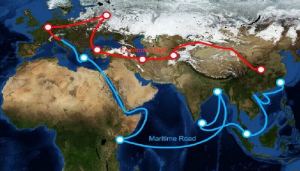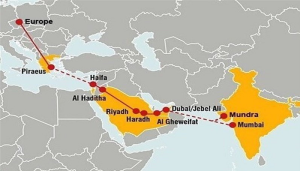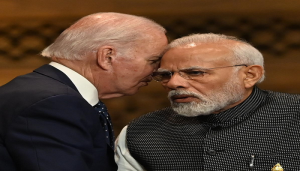Pak Sahafat – America needs more than financial capital to counter China’s economic influence, which is where India with a population of 1.4 billion comes up for America.
According to the report of Pak Sahafat International News Agency, the G20 countries in India on September 19 unveiled a corridor that will connect India to Europe by passing through the United Arab Emirates, Saudi Arabia, and Jordan and occupied Palestine. Even though America is not on the path of this corridor, it acts as the main supporter and as a thread connecting the countries under this project; but what is the main goal of America in unveiling and supporting this plan?
In this regard, we use a theory of international relations called “aggressive realism”.
John Mersheimer, a famous theorist of international relations, believes that in the framework of “offensive realism”, countries not only seek to increase their power in the regional and then global arena, but they will act as much as they can to weaken others and are always in a state of potential aggression.
Read more:
The West does not spare anyone to continue its global domination!
For this purpose, in the first place, they are trying to achieve regional hegemony, and in the second step, in the case of widespread power seeking, they are trying to achieve hegemonic power in the global arena. On the other hand, in parallel with trying to achieve this position, they try to prevent other governments from gaining increasing power, in this regard, he suggests two options: 1- balancing and 2- shifting responsibility.
For example, the United States has transferred part of the responsibility to India at the same time as taking direct action against China.

It should be noted that the United States suddenly opened the corridor for India in a situation where the results of the G20 meeting were not in line with the interests of the United States and the heavy shadow of China and Russia’s solidarity could be seen over it; Unlike the G20 meeting in Bali in November 2022, Russia’s invasion of Ukraine was not explicitly condemned, and some countries clearly stated that they do not want to serve the United States and only serve this country’s consumer market.
In this regard, the German newspaper “Hamburger Abend Blatt” raised the question in an article after the end of this meeting, why is the role of the leadership of the West in danger? And he continued to write: “The G20 meeting in India showed that the power of the West, especially Germany, is declining and there is a new star.”
On the other hand, it seems that the propaganda load of the India Corridor was strongly intended by Joe Biden, and in the opinion of the White House, Biden can present this corridor as an achievement (however apparent) among his dozens of failures in foreign policy, in front of his Republican rivals.
Another point is that the India-Europe Corridor project was proposed while next month the third meeting of “Belt and Road” partners is going to be held with the presence of the leaders of 90 countries and at the same time the tension between America and China is at its peak to the point where South China has also been drawn into military tension.

Exploiting the competition between China and India
Meanwhile, India and China are the two countries with the largest population in the world, with a total of about three billion people. At the same time, the competition between America and China for influence in the South Asian region, from the Himalayan mountains to the islands of the Indian subcontinent, can change the fate of the two countries and beyond that region and even the world; In the meantime, America is trying to free the region from China’s influence by creating differences and increasing the traditional competition between the two countries.
In this regard, “Derrick Grossman”, a former American official responsible for providing intelligence and security reports from Asia and the Pacific for the country’s deputy defense minister, wrote in the Foreign Policy magazine last month: “The good news right now is that New Delhi, Washington’s close partner, has generally been able to act as a barrier against China’s growing influence.”
According to Grossman, who is currently working as a military analyst at the RAND Institute and an assistant professor at the University of Southern California, South Asia, which includes Afghanistan, Bangladesh, Bhutan, India, Maldives, Nepal, Pakistan and Sri Lanka, has for years been the center of strategic competition between China and India.

In this context, Washington plans to join India in the group of countries sanctioning Moscow after failing to mobilize this country against Russia. to seduce and seems to hope to make New Delhi a tool to control China on his behalf.
In this regard, it is necessary to mention the meeting of the leaders of the Group of Seven on June 26, 2022 in Germany, where after several hours of intense deliberation, they announced their determination to confront China’s economic projects at the global level, with the “Belt and Road” initiative at the top of them.
But the notable line in that statement was: “Investments strengthen and diversify our supply chain, create new opportunities for American workers and businesses, and support our national security.” The partnership also provides a structure for the G7 countries to pool their resources to finance emerging economies in order to prevent China’s economic expansion within them.”
But America’s success in dealing with China requires more than financial capital, but also requires human factors, and this is where the seduction of India with the leverage of the economy, which also has border tension with China, becomes relevant for Washington.

